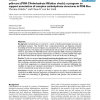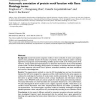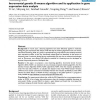BMCBI
2004
13 years 11 months ago
2004
Background: Microarray studies in cancer compare expression levels between two or more sample groups on thousands of genes. Data analysis follows a population-level approach (e.g....
BMCBI
2004
13 years 11 months ago
2004
Background: Carbohydrates are involved in a variety of fundamental biological processes and pathological situations. They therefore have a large pharmaceutical and diagnostic pote...
BMCBI
2004
13 years 11 months ago
2004
Background: Conserved protein sequence motifs are short stretches of amino acid sequence patterns that potentially encode the function of proteins. Several sequence pattern search...
BMCBI
2004
13 years 11 months ago
2004
Background: In recent years, clustering algorithms have been effectively applied in molecular biology for gene expression data analysis. With the help of clustering algorithms suc...
BMCBI
2004
13 years 11 months ago
2004
Background: Signal transduction is one of the most important biological processes by which cells convert an external signal into a response. Novel computational approaches to mapp...
BMCBI
2004
13 years 11 months ago
2004
Background: A routine goal in the analysis of microarray data is to identify genes with expression levels that correlate with known classes of experiments. In a growing number of ...
BMCBI
2004
13 years 11 months ago
2004
Background: Microarray experiments are becoming a powerful tool for clinical diagnosis, as they have the potential to discover gene expression patterns that are characteristic for...
BMCBI
2004
13 years 11 months ago
2004
Background: Identifying protein-protein interactions is fundamental for understanding the molecular machinery of the cell. Proteome-wide studies of protein-protein interactions ar...
BMCBI
2004
13 years 11 months ago
2004
Background: The two most common models for the evolution of metabolism are the patchwork evolution model, where enzymes are thought to diverge from broad to narrow substrate speci...
BMCBI
2004
13 years 11 months ago
2004
Background: Two or more factor mixed factorial experiments are becoming increasingly common in microarray data analysis. In this case study, the two factors are presence (Patients...





